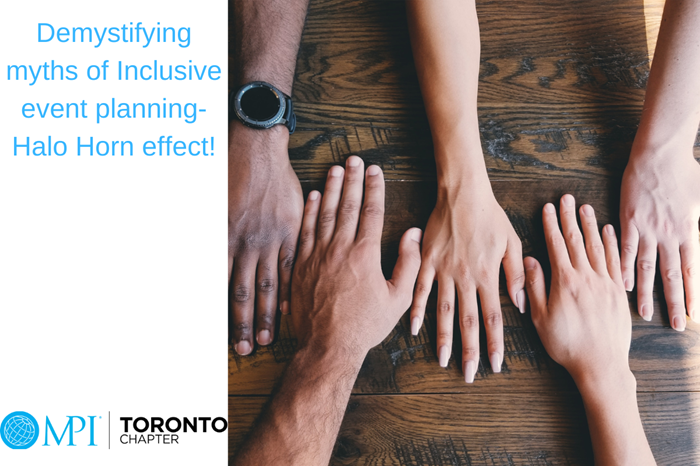How do you get the highest ROI on membership dollars for joining MPI? Get Involved!
Get Involved
Demystifying myths of Inclusive event planning- Halo Horn effect!

In September 2018, MPI launched an initiative to determine the current state of inclusion in the global meeting and event industry. The mission of the project was to determine how, and to what extent, event professionals plan for inclusivity in their events and the associated knowledge gaps when planning.
Reading through the MPI State of Inclusion in Meetings & Events report made me realize that the primary driver of unconscious bias which keeps our events far from being inclusive is the ‘Halo & Horn Effect’. When event organizers ask for post-event feedback and receive a couple of responses to accessibility questions, they view that with a ‘Halo’ effect and feel that their efforts are complete and nothing more is required. On the other hand, when organizers do see critical feedback from one attendee suggesting assistive features beyond closed-captioning, they view that with a ‘Horn’ effect - that raises questions like budget-constraints or scalability. What planners miss due to the Halo & Horn effect is a great opportunity to include a wider pool of audience and perspective, and therefor risk potential business that may choose to attend a competing event due to a lack of empathy and inclusivity of their event.
Two statistics that stood in MPI’s The State of Inclusion in Meetings & Eventsreport is that 40% of respondents said they don’t have all of the information needed to plan inclusive experiences, whereas 20% said they don’t have enough budget.
In event planning, we tend to emphasize the COSTS of addressing diversity. However, what about the costs of NOT addressing and including diversity? While I understand these issues create barriers to inclusivity, they are also great opportunities for innovation and the redesign of the event industry.
Not having a diverse team may lead to exhaustion of both the planning committee and the attendees because unless we have someone in our team to explain the critical nature of an event element, it’s easy to overlook it.
Here’s how to include more diversity on your planning team:
- Hire contingent workers that represent those diverse groups or hire Inclusive Event Strategists and consultants. Consultants can help committees develop an Inclusivity guide that can be a rinse and repeat for more than one event.
- Partner with diverse vendors, suppliers and service providers who will help in breaking down knowledge barriers and, in many cases, give advice on a more collaborative experience. When you have a diverse representation from internal stakeholders and your audience, you have a greater opportunity of executing content and thought diversity.
- Content Crowdsourcing gives your audience the event canvas, allowing them to shape and design the event content and experience.
- Create a taskforce, panel nomination, or pre-event design survey to learn what matters to your attendees the most. The more engaged attendees are in crafting their event experience, the more likely for them to attend and engage with your brand.
Before moving forward with the planning of an event, planners must first measure the effects on attendee acquisition and its diversity as you make critical planning decisions: Beyond the lists and database, who is your target audience?
 Evaluate your Event Goals and their impact upon your DEI strategies. Consider who is in the room when you are making those critical decisions. Are the decision-makers you have in the room diverse in perspective? How has your target audience been engaging with your content, speakers, and events in the past?
Evaluate your Event Goals and their impact upon your DEI strategies. Consider who is in the room when you are making those critical decisions. Are the decision-makers you have in the room diverse in perspective? How has your target audience been engaging with your content, speakers, and events in the past?
Answers to these questions help to design an attendee persona that considers different perspectives.
- Engage with a diverse organizing committee both internally and externally. Together, you can look for opportunities and flag possible blind spots. For instance, might your tentative event date fall over a major religious or cultural holiday? A quick google search is all you need to avoid that miss.
- Include speakers from diverse backgrounds, professions, and demographics. Too often I see the same faces presenting at events and typically they say the same things. A diverse panel will present new ideas and provoke more thoughts, making your audience feel more represented.
After almost a decade long discussion, we’ve finally concluded that Diversity and Inclusivity is as important in events as in the world. Every event planner is expected to have an inclusivity element in their events. Unfortunately, many event planners mistakenly assume that with DEI initiatives, they have to focus on single representation such as race or ethnicity. And if they widen the scope of their event to include disabled people, they’ll be accommodating a minority of participants. Well, a study by CDC suggests, 1 in 4 American adults have a Disability. This means those with a Disability are the largest minority group!
Isn’t it time that we rethink and create events to be more inclusive? And going hybrid is a step towards giving your event attendees the freedom of choice.
About the Author:
 Sonali Nair CMP, DES
Sonali Nair CMP, DES
Diversity & Inclusion Evangelist
http://linkedin.com/in/sonalinair

Leave a commentOrder by
Newest on top Oldest on top